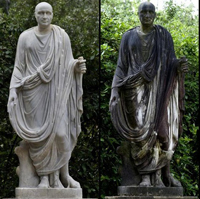Saturday, November 13, 2010 hours 15:45
Methods and techniques used in the restoration process of outdoor sculptures
 Istituto per l'Arte e il Restauro Istituto per l'Arte e il Restauro
Training Area - Saturday November 13- from 3:45 p.m. to 4:30 p.m.
This technical meeting focuses on some proposals of interventions of conservation and on the observation of some restoration sites of open air sculpture. There will be also treated some of the causes of deterioration of marble and stone artefacts as for example climatic conditions (heavy rain, sun, wind, etc), and the methodologies and the techniques used in the difficult operations of cleaning the surface by the “writings” originated by vandalism. It is quite clear that a stone surface altered by physic and chemical factors can be easily infested by biological deteriorations factors. In fact after the removal of the biological patina, there are increased values of surface porosity with a subsequent weakness of the surface in case of new biological damages. The sculptures which was examined in this study show a very interesting condition, from the point of view of the biological deterioration. The proposed intervention of conservation is as a sort of challenge faced by conservators and restorers, against a lot of external and climatic factors. The first step of a restoration process in fact, is based on a series of efforts made to reduce and stop the materials deterioration process. The mechanical cleaning of the black crusts is carried out by means of the laser technology and it is often a resolutive action. The methodology based on the use of ammonium oxalate used by the Opificio delle Pietre Dure of Florence can also stop the materials deterioration process. But the treatment with artificial oxalates needs a surface without any fissative agent. It has a superficial consolidant effect and after the treatment each grain of the structure is covered by a sort of protective and defensive shell. Besides, the application of protective films, in porous materials and in case of acid rains, determines the crystallization process of the internal salts, above all if the external ambient has high values of humidity. The obtained adhesive film could also fix the atmospheric particles with a subsequent creation of altered chromatic parts on the artefact surface which are subject more than the other parts to the ageing factors and to the chemical and biological deterioration process.
Speaker: Isidoro Castello.
web site |

















